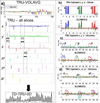SimPACE: generating simulated motion corrupted BOLD data with synthetic-navigated acquisition for the development and evaluation of SLOMOCO: a new, highly effective slicewise motion correction
- PMID: 24969568
- PMCID: PMC4165749
- DOI: 10.1016/j.neuroimage.2014.06.038
SimPACE: generating simulated motion corrupted BOLD data with synthetic-navigated acquisition for the development and evaluation of SLOMOCO: a new, highly effective slicewise motion correction
Abstract
Head motion in functional MRI and resting-state MRI is a major problem. Existing methods do not robustly reflect the true level of motion artifact for in vivo fMRI data. The primary issue is that current methods assume that motion is synchronized to the volume acquisition and thus ignore intra-volume motion. This manuscript covers three sections in the use of gold-standard motion-corrupted data to pursue an intra-volume motion correction. First, we present a way to get motion corrupted data with accurately known motion at the slice acquisition level. This technique simulates important data acquisition-related motion artifacts while acquiring real BOLD MRI data. It is based on a novel motion-injection pulse sequence that introduces known motion independently for every slice: Simulated Prospective Acquisition CorrEction (SimPACE). Secondly, with data acquired using SimPACE, we evaluate several motion correction and characterization techniques, including several commonly used BOLD signal- and motion parameter-based metrics. Finally, we introduce and evaluate a novel, slice-based motion correction technique. Our novel method, SLice-Oriented MOtion COrrection (SLOMOCO) performs better than the volumetric methods and, moreover, accurately detects the motion of independent slices, in this case equivalent to the known injected motion. We demonstrate that SLOMOCO can model and correct for nearly all effects of motion in BOLD data. Also, none of the commonly used motion metrics was observed to robustly identify motion corrupted events, especially in the most realistic scenario of sudden head movement. For some popular metrics, performance was poor even when using the ideal known slice motion instead of volumetric parameters. This has negative implications for methods relying on these metrics, such as recently proposed motion correction methods such as data censoring and global signal regression.
Keywords: BOLD; Functional MRI; Functional connectivity; Motion correction; Spin history.
Copyright © 2014 Elsevier Inc. All rights reserved.
Figures








References
-
- Andersson JL, Hutton C, Ashburner J, Turner R, Friston K. Modeling geometric deformations in EPI time series. Neuroimage. 2001;13:903–919. - PubMed
-
- Ardekani BA, Bachman AH, Helpern JA. A quantitative comparison of motion detection algorithms in fMRI. Magn Reson Imaging. 2001;19:959–963. - PubMed
-
- Beall EB. Adaptive cyclic physiologic noise modeling and correction in functional MRI. J Neurosci Methods. 2010;187:216–228. - PubMed
Publication types
MeSH terms
Grants and funding
LinkOut - more resources
Full Text Sources
Other Literature Sources
Medical

